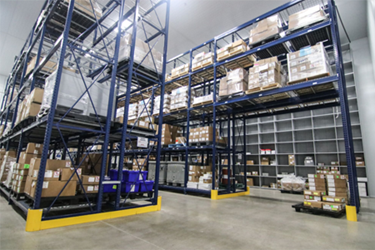Pop-Up Distribution Centers Bring Retailers Closer To Customers
By Nishith Rastogi, Founder, and CEO, Locus

The term “pop-up” isn’t just for fly balls in baseball or annoying ads on your screen. The phrase has been used to define temporary sites for retail sales for several years, but recently, more people are using it to describe a type of distribution center (DC) that helps retailers around the world meet growing demand and address significant challenges in connecting consumers with products.
As the world struggles with the pandemic, and especially during the initial outbreaks when everyone was still adjusting, retailers had to get creative to manage the supply chain issues and increased demand that made it difficult to get products to customers. Pop-up DCs have been a key piece of the puzzle for a growing number of retailers, and pop-up DCs will be useful long after the pandemic ends since consumer expectations have changed.
What Makes Pop-Up Distribution Centers Different
Traditional DCs are massive warehouses that are often located many miles away from urban centers where land is more affordable. Companies operate traditional DCs to keep a large supply of products on hand in a region, and the retailer’s fleet and/or outsourced fleets transport products to local stores in the region as needed to keep store inventory at optimal levels.
If you’ve ever visited a shopping mall during peak purchasing seasons or when there’s a special event for a promotion or product launch, you may have noticed pop-up kiosks that supplement in-store inventory at a closer range than a traditional DC. Retailers rent the extra space to keep supply close to demand.
Pop-up DCs operate similarly, and retailers have used them extensively during the pandemic to satisfy the demand for customers under lockdown. Pop-up DCs help eCommerce or brick-and-mortar retail stores meet spikes in demand by storing products in temporary warehouse facilities in multiple locations that are closer to population centers, allowing for a faster delivery time.
How Pop-Up Distribution Centers Help Retailers Address Disrupted Supply Chains
Remember the great toilet paper shortage of 2020? That was a supply chain issue that occurred when demand for toilet paper in commercial buildings, stores, schools, hotels, etc., vanished practically overnight in the U.S. and was replaced by heightened demand for consumer-packaged toilet paper.
There wasn’t a true shortage of toilet paper, at least not at first. It was a supply chain disruption that morphed into a true shortage because people sparked panic buying. To address it, companies had to retool business-to-business (B2B) logistics into a business-to-consumer (B2C) supply chain model, which requires a different approach because the expectations of the end customer are different.
Pop-up DCs were instrumental in the conversion to a B2C model for some retailers because they provide a way to distribute products to consumers more quickly, in keeping with the same-day or two-day delivery expectations customers have now. That’s just one example of how pop-up DCs in high-density areas can help retailers ensure timely order fulfillment in a way that distant traditional DCs can’t match.
Pros And Cons For Retailers
So, is a pop-up DC right for your retail operation? There’s one simple question that can give you a hint: Do the processes you have in place now keep up with customer demand? Retailers who have traditional DCs near their customers may be able to keep up, but if your buyers are located too far from your regional DC, a pop-up DC strategy may be the answer to faster delivery.
Pop-up DCs have been around for a while in some urban areas, but they became more mainstream for retailers during the pandemic when more people than ever before relied on digital channels to get the products they need. Pop-up DCs give retailers greater process control, from packaging to the door drop, enabling expedited delivery to overcome supply chain disruptions.
As vaccine distribution ramps up and the world begins to get the virus under control, the prospect of sudden supply chain disruptions may fade as a primary concern, but consumer purchasing patterns will remain similar when it comes to demand and rapid delivery expectations. Other considerations also will persist, including the environmental impact of distribution, the need to assert greater control over supply chain processes, and the business imperative of improving the customer experience.
Addressing these priorities will require new business processes, including route optimization, dynamic network design, and data analytics. It’s important to keep in mind that the pandemic heightened consumer expectations around delivery. In the coming months, retailers with products close to consumers will be best positioned to meet their expectations, and pop-up DCs bring you closer.
